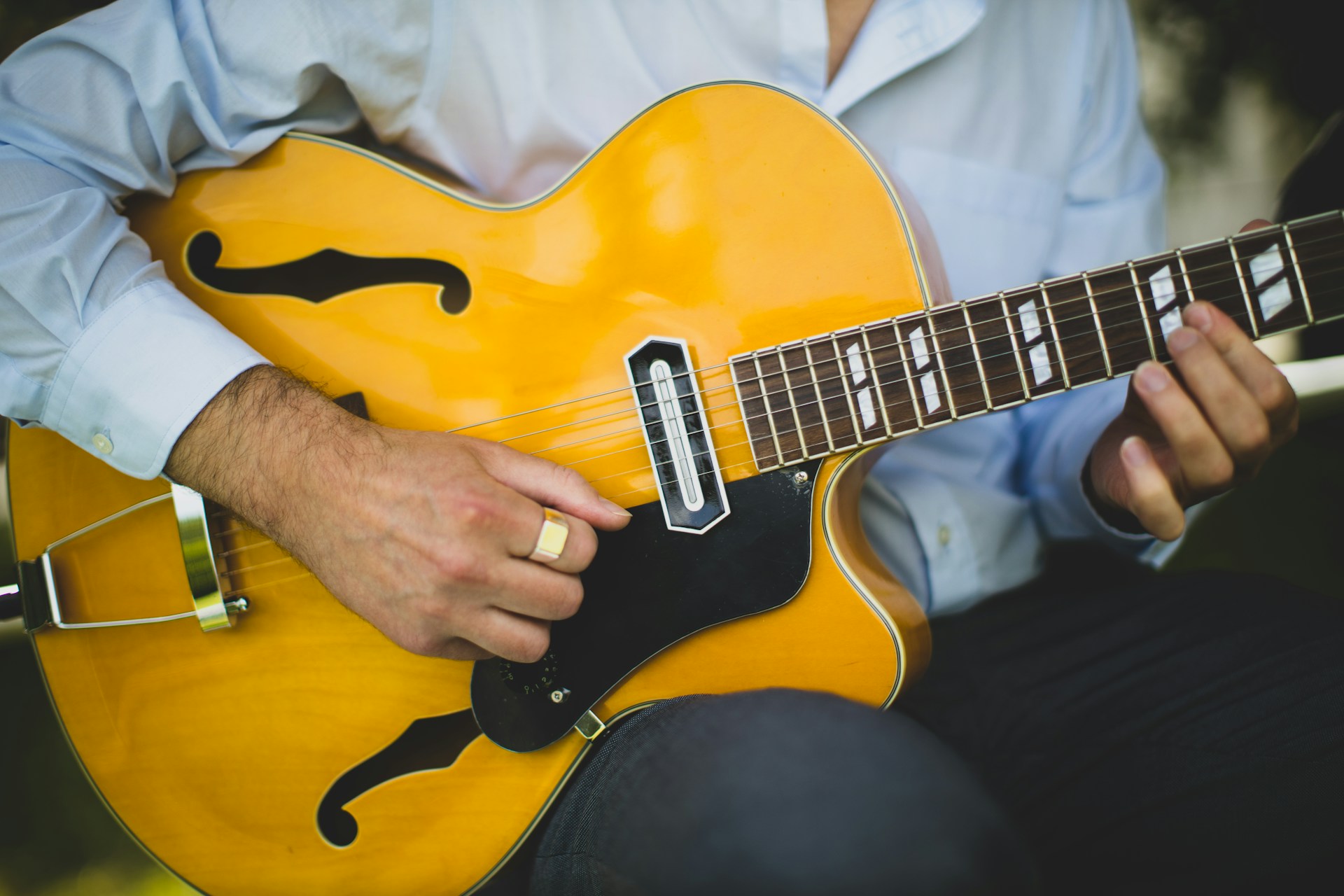Picture this: a lone musician on a stage, strumming away at their guitar, transforming the air around them with the power of just a few simple chords. From the heavy riffs of rock to the twangy melodies of country, guitar chords have the incredible ability to shape and define entire music genres. Let’s dive into the world of chords and discover just how transformative they can be in shaping the sounds we know and love.
Contents
- 1 Exploring the Fundamentals of Guitar Chords
- 2 The Role of Chords in Defining Musical Genres
- 3 Innovations in Chord Progressions Across Rock Music
- 4 The Emotional Impact of Minor and Major Chords in Blues
- 5 Folk Music and the Simplicity of Open Chords
- 6 Jazz Guitar Chords: Complexity and Sophistication
- 7 The Future of Guitar Chords in Music Evolution
- 8 FAQs
- 9 Rock on with Those Chords!
Exploring the Fundamentals of Guitar Chords
So you’ve decided to dive into the wonderful world of guitar chords, huh? Get ready for a wild ride filled with finger contortions and musical magic!
First things first, let’s talk about the backbone of any chord – the notes. Each chord is made up of three or more notes that create a harmonious sound when played together. Think of them as the ingredients in a delicious musical recipe.
Next up, we have finger positions. This is where the real fun begins! Each chord has a specific set of finger positions that you’ll need to master in order to play it correctly. Get ready to twist your fingers into some seriously weird shapes!
Now, onto the strumming. Once you’ve nailed down those finger positions, it’s time to add some rhythm to your chord progressions. Experiment with different strumming patterns to find the groove that makes your heart sing.

The Role of Chords in Defining Musical Genres
Ever wondered why certain songs make you want to twirl in a field of flowers while others have you headbanging like there’s no tomorrow? Well, my friend, it all comes down to one magical musical element – chords!
Chords are like the secret sauce of music genres, adding that special flavor that makes each one unique. Whether it’s the dreamy, ethereal quality of a major seventh chord in a pop ballad or the gritty, raw power of a power chord in a rock anthem, chords play a crucial role in defining the sound and feel of a genre.
Take jazz, for example. It’s all about those smooth, complex chords that make you feel like you’re sipping a fancy cocktail in a dimly lit jazz club. Or how about metal? Power chords are the bread and butter of this genre, creating that intense, headbanging energy that gets your heart pumping.
So next time you’re jamming out to your favorite song, pay attention to the chords – they hold the key to unlocking the magical world of musical genres!

Innovations in Chord Progressions Across Rock Music
Rock music has always been known for its iconic chord progressions, but recent innovations in this area have taken things to a whole new level. From unexpected key changes to intricate harmonic structures, rock musicians are constantly pushing the boundaries of what is possible with chord progressions.
One exciting development is the use of **modal interchange**, where chords from different modes are used interchangeably within a single progression. This creates a unique and captivating sound that keeps listeners on their toes. Bands like Radiohead and Queens of the Stone Age have been pushing this technique to new heights, creating complex and emotionally-charged progressions that defy traditional music theory.
Another trend in rock music is the **use of odd time signatures** in chord progressions. Bands like Tool and Porcupine Tree have embraced this approach, creating music that is both mathematically precise and emotionally powerful. By incorporating odd time signatures like 7/8 or 5/4 into their progressions, these bands are able to create a sense of tension and release that is truly captivating.
Overall, the future of chord progressions in rock music looks bright. With bands constantly pushing the boundaries of what is possible harmonically, we can expect to hear even more innovative and exciting progressions in the years to come. So crank up the volume and get ready to be blown away by the next wave of chord progression innovations in rock music!

The Emotional Impact of Minor and Major Chords in Blues
When it comes to music, it’s like trying to choose between a pint of ice cream and a slice of bacon – both are delicious in their own unique way! Minor chords evoke a sense of melancholy, longing, and heartache, while major chords bring warmth, hope, and joy to the listener’s ears.
In a typical blues song, the contrast between minor and major chords creates a rollercoaster of emotions that can make you feel like you’re riding the world’s most emotional rollercoaster. Just when you think you’ve hit rock bottom with those soul-crushing minor chords, a major chord swoops in like a musical superhero to lift your spirits and make you want to dance it all away.
So, the next time you find yourself listening to a blues song and feeling like you’re on an emotional wild ride, remember that it’s all part of the magic of those minor and major chords working their mojo on your heartstrings. And if you need a little extra pick-me-up, just hit repeat and let those major chords come to the rescue!
Folk Music and the Simplicity of Open Chords
Who needs complex jazz chords or intricate fingerpicking patterns when you can strum along to the simple beauty of open chords in folk music? There’s something so refreshing about the straightforward nature of folk music and its reliance on these basic chord progressions.
With just a few simple chords like G, C, D, and E minor, you can play countless folk songs that tug at the heartstrings and get toes tapping. There’s no need to overcomplicate things when you can achieve such a rich, melodic sound with just a handful of chords.
So put down that daunting chord dictionary and embrace the simplicity of folk music. Let the sweet harmonies of open chords transport you to a cozy, fireside jam session with friends. Grab your acoustic guitar, strum away, and feel the stress melt away with each chord change.
And remember, sometimes less is more when it comes to music. Embrace the simplicity of open chords in folk music and let the music speak for itself. Happy strumming!
Jazz Guitar Chords: Complexity and Sophistication
When it comes to jazz guitar chords, one word comes to mind: complexity. These chords are so intricate and sophisticated, they make the average person’s head spin faster than a Charlie Parker solo. With their complex voicings and extensions, jazz guitarists are basically playing a game of musical Jenga – one wrong move, and the whole thing comes crashing down.
But fear not, aspiring jazz guitarists! With great complexity comes great sophistication. While your fingers may ache from trying to contort themselves into bizarre shapes on the fretboard, the end result is worth it. Jazz chords are like fine wine – the more complex and sophisticated they are, the better they sound. So keep practicing those augmented 7ths and diminished 9ths, and soon you’ll be impressing jazz aficionados from here to Mars.
One of the keys to mastering jazz guitar chords is to understand the theory behind them. It’s not enough to simply memorize shapes and fingerings – you need to know why these chords work the way they do. Dive deep into music theory, dissect those chord progressions, and soon you’ll be speaking the secret language of jazz guitarists everywhere.
So don’t be intimidated by the complexity and sophistication of jazz guitar chords. Embrace the challenge, practice until your fingers bleed, and remember: in the world of jazz, the more complex and sophisticated you sound, the cooler you’ll be. And who doesn’t want to be the coolest cat on the block?
The Future of Guitar Chords in Music Evolution
Are you tired of the same old guitar chords in every song you hear? Well, fear not, fellow music enthusiasts, because the future of guitar chords is here to shake things up!
Imagine a world where traditional chord progressions are a thing of the past, and musicians are experimenting with new and innovative ways to create music. Picture a symphony of sounds that defy convention and break the mold of what we know as standard chords.
With advancements in technology and the creative minds of musicians pushing boundaries, we can expect to see a revolution in the way guitar chords are used in music. From unconventional tunings to complex fingerings, the possibilities are endless!
So, grab your guitar and get ready to embark on a musical journey like never before. The future of guitar chords is bright, bold, and bound to leave you in awe of the endless possibilities that await. Let’s embrace the evolution of music and witness the magic that awaits us!
FAQs
Why do guitar chords play such a significant role in shaping different music genres?
Oh, let me tell you, guitar chords are like the secret sauce that gives each music genre its unique flavor. Whether it’s the soothing sounds of jazz or the headbanging tunes of metal, guitar chords set the tone and mood for the entire song. It’s like the magical ingredient that keeps us grooving!
How do different guitar chords contribute to the overall vibe of a song?
Well, my friend, different chords have different personalities. Just like people! Major chords are happy-go-lucky and perfect for those feel-good pop songs, while minor chords are a bit emo and bring out the drama in ballads. And don’t even get me started on those spicy diminished chords that add a touch of mystery to the mix. It’s all about finding the right chords to express the emotion you’re trying to convey.
Can guitar chords be considered the building blocks of a song?
Absolutely! Think of guitar chords as the Lego bricks of music. You start with a few simple chords, stack them up in different ways, and voila! You’ve got yourself a catchy melody or a killer riff. It’s all about playing around with those chords and finding the perfect combination that makes your song stand out from the rest. So, grab your guitar and start building!
How do musicians use guitar chords to experiment and innovate within their genres?
Oh, musicians are like mad scientists when it comes to experimenting with guitar chords. They’ll throw in some funky extensions, add a dash of dissonance, or even flip the traditional chord progression on its head. It’s all about pushing the boundaries and creating something fresh and exciting. Who knows, maybe the next big music trend will be born out of a crazy guitar chord experiment!
Rock on with Those Chords!
And there you have it – the transformative power of guitar chords in shaping different music genres. So go ahead, pick up that guitar and start strumming away! Who knows, maybe you’ll be the next rock legend or pop sensation. Just remember, it’s all about those chords!



